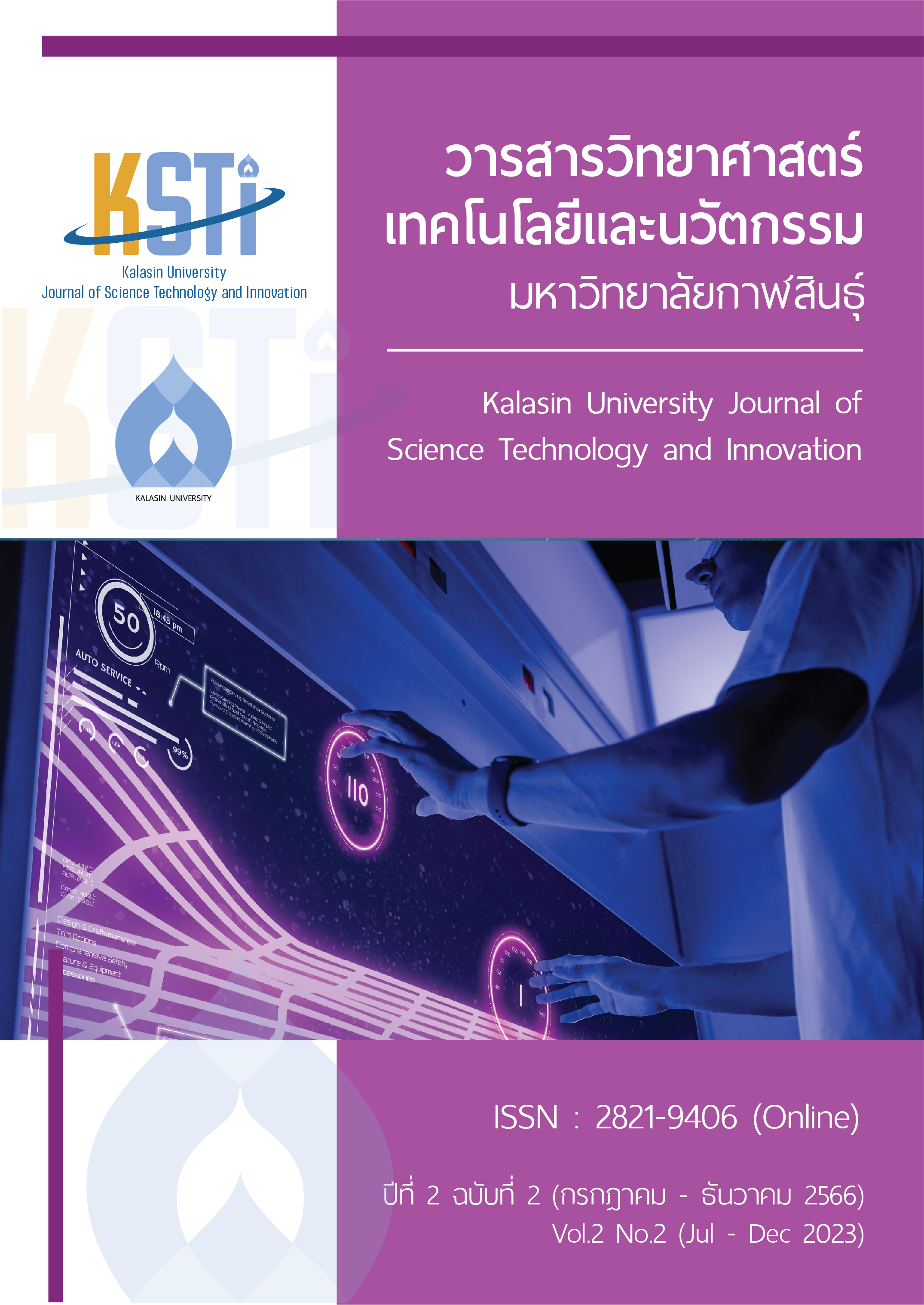Effects of fermenting cassava peel with rice straw on its nutritive value
Main Article Content
Abstract
The objective of this study was to examine the effects of fermenting cassava peel with rice straw on its nutritive value. The experiment followed a 2 x 7 factorial arrangement in a completely randomized design. Factor A represented ensiling times (21 and 35 days), while factor B consisted of 7 ratios of cassava peel to rice straw: 0:100, 20:80, 40:60, 50:50, 60:40, 80:20 and 100:0, each replicated three times. All ratios of cassava peel with rice straw were supplemented with 3% molasses and 3% urea of dry matter. The findings revealed no significant interaction effect (P>0.05) between ensiling times and the ratio of cassava peel to rice straw on the nutritive values of fermented cassava peel with rice straw. The ensiling times of 21 and 35 days had no significant impact on the nutritional value of the fermented cassava peel with straw (P>0.05). Increasing the proportion of cassava peel resulted in a decrease of dry matter, neutral detergent fiber (NDF) and acid detergent fiber (ADF) of the fermented cassava peel with rice straw (P<0.05). However, fermenting cassava peel with rice straw led to an increase of crude protein of fermented cassava peel (P<0.05) when compared to rice straw fermentation alone (0:100). In conclusion fermenting cassava peel with rice straw, along with the addition of 3% molasses and 3% urea can enhance the quality of roughage sources.
Downloads
Article Details

This work is licensed under a Creative Commons Attribution-NonCommercial-NoDerivatives 4.0 International License.
The owner (Research and Development Institute, Kalasin University), the authors agree that any copies of the article or any part thereof distributed or posted by them in print or electronic format as permitted will include the notice of copyright as stipulated in the journal and a full citation to the final published version of the contribution in the journal as published by Research and Development Institute, Kalasin University.
References
Ferreira, G.D.G. Oliveira, R.L. Cardoso, E.C. Magalhães and A.L.R. Brito. Nutritive value of cassava by-products. Rev. Bras. Saúde Prod. 2007; 4: 364–374.
จักรกริช หอมขาว. การเพิ่มโปรตีนในผลิตภัณฑ์มันสำประหลังโดยใช้จุลินทรีย์ และผลการใช้ผลิตภัณฑ์มันสำปะหลังหมักทดแทนอาหารข้นในโคเจาะกระเพาะต่อการหมักย่อยในกระเพาะหมัก (วิทยานิพนธ์ปริญญาวิทยาศาสตรมหาบัณฑิต). สาขาวิชาเทคโนโลยีการผลิตสัตว์, สำนักวิชาเทคโนโลยีการเกษตร. นครราชสีมา: มหาวิทยาลัยเทคโนโลยีสุรนารี; 2555.
สุภัตรา โอกระโทก. ผลของการใช้กากมันสำปะหลังหมักด้วยเชื้อรา Aspergillus oryzae เพื่อเป็นอาหารในไก่ไข่ (วิทยานิพนธ์ปริญญาวิทยาศาสตรมหาบัณฑิต). สาขาวิชาเทคโนโลยีการผลิตสัตว์, สำนักวิชาเทคโนโลยีการเกษตร. นครราชสีมา: มหาวิทยาลัยเทคโนโลยีสุรนารี; 2555.
Gunun, P., A. Cherdthong, P. Khejornsart, M. Wanapat, S. Polyorach, W. Kaewwongsa and N. Gunun. Replacing Concentrate with Yeast- or EM-Fermented Cassava Peel (YFCP or EMFCP): Effects on the Feed Intake, Feed Digestibility, Rumen Fermentation, and Growth Performance of Goats. Animals. 2023; 13: 1-9.
นพรัตน์ ผกาเชิด ทิพย์สุดา บุญมาทัน ธนิตพันธ์ พงษ์จงมิตร และ ฐิติมา นรโภค. ผลของการเสริมยีสต์ (Saccharomyces cerevisiae) และลูกแป้งข้าวหมากต่อคุณค่าทางโภชนะของเปลือกมันสำประหลังหมัก. แก่นเกษตร. 2562. 47 (ฉบับพิเศษ 2): 819-824.
AOAC. Official Methods of Analysis.14th Edition, Association of Official Analytical Chemists, Washington DC. 1995.
Van Soest, P. J., Robertson, J. B., and A. B., Lewis. Methods for dietary fiber, neutral detergent fiberand nonstarch polysaccharides in relation to animal nutrition. Journal Dairy Science. 1991, 74(10): 3583-3597.
SAS. SAS/STAT User’s Guide: Version 6. 4th Edition. SAS Institute Inc., Cary, NC. 1998.
นพรัตน์ ผกาเชิด ครรชิต ปัดชาศรี ธีระพงษ์ เรืองช่อ ศราวุฒิ ภูปาทา ทิพย์สุดา บุญมาทัน และธนิตพันธ์ พงษ์จงมิตร. ผลของระดับยีสต์ (Saccharomyces cerevisiae) ต่อคุณค่าทางโภชนะของเปลือกมันสำปะหลังหมัก. วารสารวิทยาศาสตร์เกษตร. 2560, 48 (2) (พิเศษ) : 659-665.
ณรกมล เลาห์รอดพันธ์ วิโรจน์ ลิขิตตระกูลวงศ์ ประวิทย์ ห่านใต้ ทศพร อินเจริญ บุญฑริกา ปลั่งสูงเนิน และ เสาวลักษณ์ แย้มหมื่นอาจ. การเปรียบเทียบวิธีการปรับสภาพฟางข้าวปรุงแต่งด้วยยูเรียที่แตกต่างกันต่อองค์ประกอบทางเคมี และการย่อยสลายในหลอดทดลอง. วารสารวิชาการวิทยาศาสตร์และวิทยาศาสตร์ประยุกต์. 2562, 1: 83-92.
เมฆ ขวัญแก้ว พิพัฒน์ เหลืองลาวัณย์ และวิศิษฐิพร สุขสมบัติ. การใช้เปลือกมันสำปะหลังและกากมันสำปะหลัง เป็นส่วนผสมในการผลิตอาหารหยาบหมัก. วารสารวิทยาศาสตร์และเทคโนโลยี มหาวิทยาลัยอุบลราชธานี. 2556, 12(3): 92-103.


